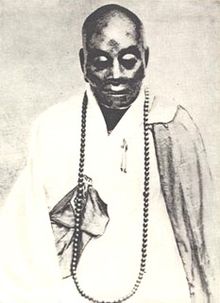Huineng
| Huineng |
|
|---|---|

Mummy of Huineng
|
|
| School | Chan Buddhism |
| Personal | |
| Born | 638 Guangzhou, China |
| Died | 713 (aged 75) |
| Senior posting | |
| Title |
Chan master 6th Chán Patriarch |
| Predecessor | Daman Hongren |
| Successor |
Caodong/Sōtō School: Qingyuan Xingsi Linji/Rinzai School: Nanyue Huairang |
| Religious career | |
| Teacher | Daman Hongren |
| Students |
Nanyue Huairang Qingyuan Xingsi Nanyang Huizhong Yongjia Xuanjue Shenhui |
| Huineng | |||||||||||||||||||||||||
| Chinese name | |||||||||||||||||||||||||
|---|---|---|---|---|---|---|---|---|---|---|---|---|---|---|---|---|---|---|---|---|---|---|---|---|---|
| Chinese | 惠能 | ||||||||||||||||||||||||
|
|||||||||||||||||||||||||
| Japanese name | |||||||||||||||||||||||||
| Kanji | 惠能 | ||||||||||||||||||||||||
| Kana | えのう | ||||||||||||||||||||||||
|
|||||||||||||||||||||||||
| Transcriptions | |
|---|---|
| Standard Mandarin | |
| Hanyu Pinyin | Huìnéng |
| Gwoyeu Romatzyh | Hueyneng |
| Wade–Giles | Hui4-neng2 |
| Yue: Cantonese | |
| Yale Romanization | Waih-nàhng |
| Jyutping | Wai6-nang4 |
| Southern Min | |
| Hokkien POJ | Huī-lîng |
| Middle Chinese | |
| Middle Chinese | Hwèj-nong |
| Transcriptions | |
|---|---|
| Romanization | Enō |
Huineng (Chinese: 惠能; pinyin: Huìnéng, 638–713) was a Buddhist monk who is one of the most important figures in Chan Buddhism according to standard hagiographies. Huineng has been traditionally viewed as the Sixth and Last Patriarch of Chan Buddhism.
His posthumous name is Dajian (Chinese: ; pinyin: Dàjiàn; Wade–Giles: Ta4-chien4).
Most modern scholars doubt the historicity of traditional biographies and works written about Huineng. The two primary sources for Huineng's life are the preface to the Platform Sutra and the Transmission of the Lamp.
Huineng was born into the Lu family in 638 A.D. in Xinzhou (present-day Xinxing County) in Guangdong province. His father died when he was young and his family was poor. As a consequence, Huineng had no opportunity to learn to read or write and is said to have remained illiterate his entire life.
The Platform Sūtra of the Sixth Patriarch is attributed to Huineng. It was constructed over a longer period of time, and contains different layers of writing. It is...
...a wonderful melange of early Chan teachings, a virtual repository of the entire tradition up to the second half of the eighth century. At the heart of the sermon is the same understanding of the Buddha-nature that we have seen in texts attributed to Bodhidharma and Hongren, including the idea that the fundamental Buddha-nature is only made invisible to ordinary humans by their illusions".
The Platform Sūtra cites and explains a wide range of Buddhist scriptures listed here in the order of appearance:
According to the Platform Sutra, one day while delivering firewood to a store, Huineng heard a customer reciting the Diamond Sutra and had an awakening. He immediately inquired about the sutra, and decided to seek out the Fifth Patriarch, Daman Hongren, at his monastery on Huang Mei Mountain. Some later versions of the story have the customer giving him 10 or 100 taels of silver to provide for his aged mother. After travelling for thirty days on foot, he arrived at Huangmei Mountain, where the Fifth Patriarch was presiding.
...
Wikipedia
